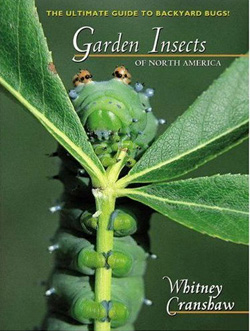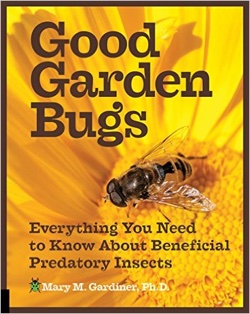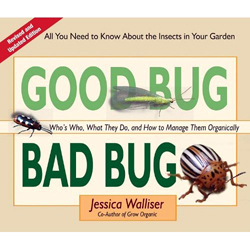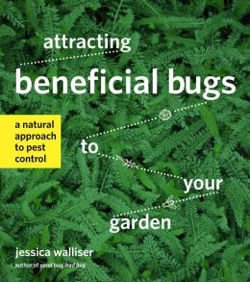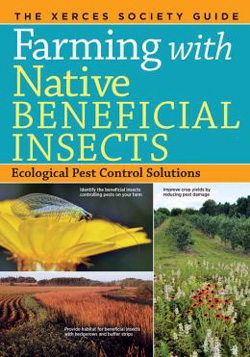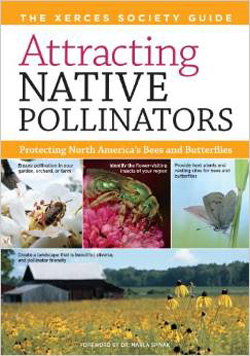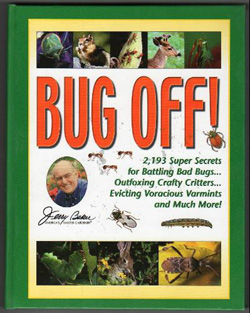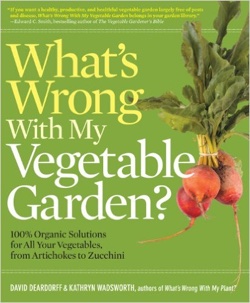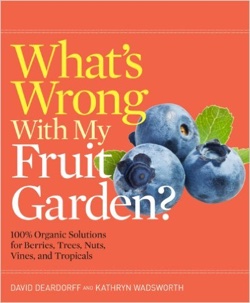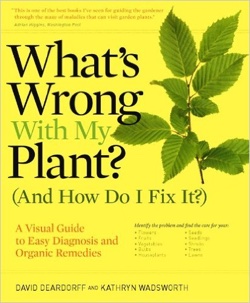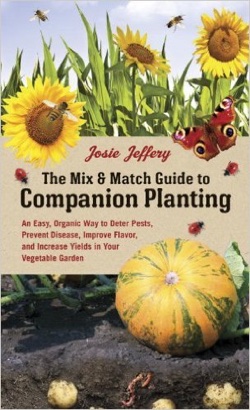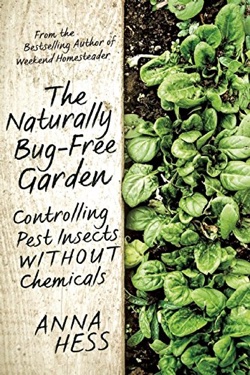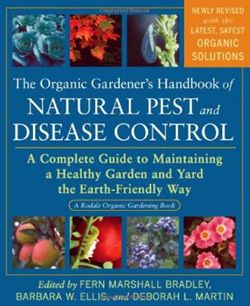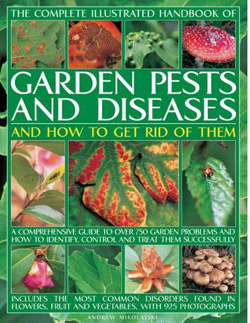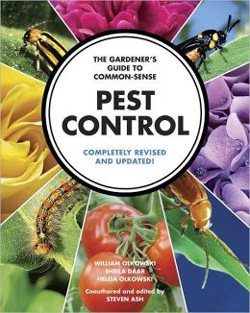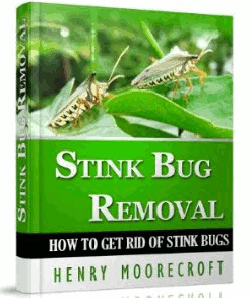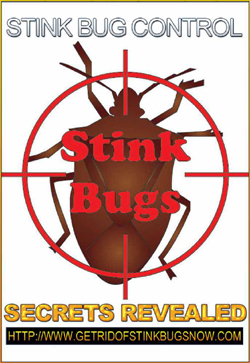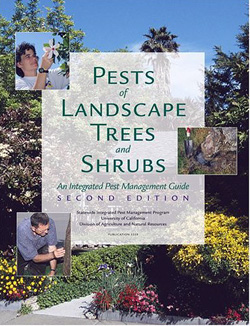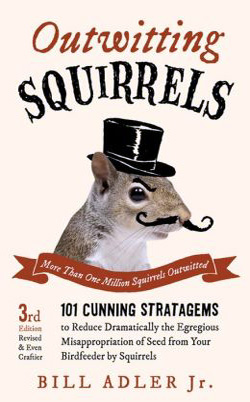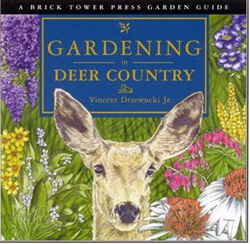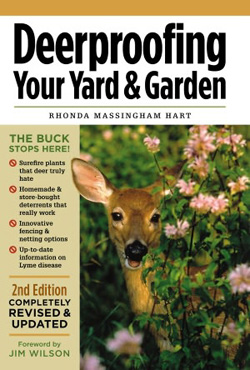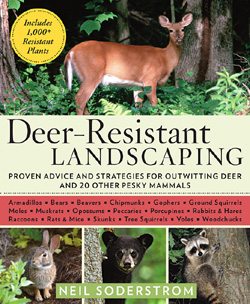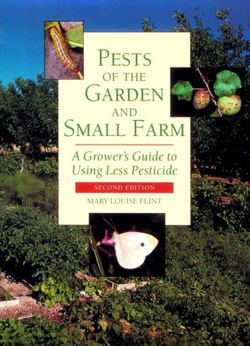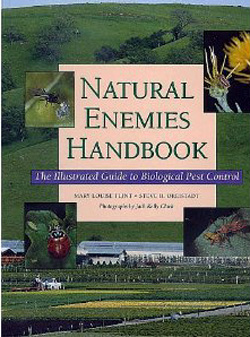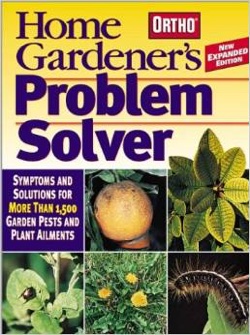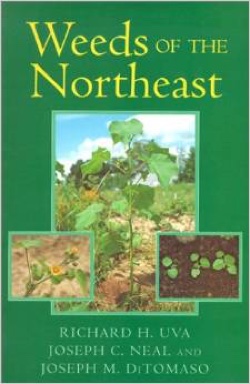
Garden Pest Books
A large selection of Garden Pest Books are shown below.
Links are provided to Amazon.com where you can find out more about these books, and if you like, purchase them.
Scroll down to see all the books.
Link to: Amazon.com
Garden Insects of North America
The Ultimate Guide to Backyard Bugs
- by Whitney Cranshaw - 2004
Garden Insects of North America is the most comprehensive and user-friendly guide to the common insects and mites affecting yard and garden plants in North America. In a manner no previous book has come close to achieving, through full-color photos and concise, clear, scientifically accurate text, it describes the vast majority of species associated with shade trees and shrubs, turfgrass, flowers and ornamental plants, vegetables, and fruits--1,420 of them, including crickets, katydids, fruit flies, mealybugs, moths, maggots, borers, aphids, ants, bees, and many, many more. For particularly abundant bugs adept at damaging garden plants, management tips are also included. Covering all of the continental United States and Canada, this is the definitive one-volume resource for amateur gardeners, insect lovers, and professional entomologists alike.
Good Garden Bugs: Everything You Need to Know About Beneficial Predatory Insects - by Mary M. Gardiner - 2015
Good Garden Bugs is an easy-to-follow reference to beneficial insects that provide pest control, allowing your garden to grow full and bountiful. Aphids, caterpillars, grubs, and slugs are not only creepy-crawlies: They can wreak havoc on your garden and plants. But fear not! You don't need dangerous chemicals to enjoy a lively, healthy garden. The secret? More lady beetles, fewer aphids! Wildlife in your garden--especially insects--can be natural pesticide alternatives. From mantids to beetles to wasps, spiders, and everything in between, entomologist Mary Gardiner tells you how to identify these beneficial bugs, how to enhance your home landscape as a habitat, and how to work with them to grow and enjoy your garden.
Good Bug Bad Bug: Who's Who, What They Do, and How to Manage Them Organically
- by Jessica Walliser - 2011
Good Bug Bad Bug, updated 2nd edition, is an indispensable field guide for quickly and easily identifying the most common invasive and beneficial insects in the garden; plus the best organic advice on how to attract the good guys and manage the bad guys - without reaching for the toxic chemicals. Includes strategies for dealing with the “new bugs in town,” those worrisome strangers that are starting to show up due to climate change (and some that have just flown in from abroad). Forty-one bugs, presented in full color on laminated card stock, with concealed wire binding. Sturdy enough to take into the garden for easy reference. An attractive gift book for adults and curious kids alike. The 2nd edition contains a number of color photographs not seen in the 1st edition and presents three new "bad bugs" to add to the rogues gallery of insect pests.
Attracting Beneficial Bugs to Your Garden
- by Jessica Walliser - 2013
It may seem counterintuitive to want bugs in a garden, but insects are indeed valuable garden companions. Especially those species known for eating the bugs that eat plants. Assassin bugs, damsel bugs, and predatory stink bugs are all carnivores that devour the bugs that dine on a garden. Attracting Beneficial Bugs to Your Garden is a book about bugs and plants, and how to create a garden that benefits from both.
Farming with Native Beneficial Insects
- by The Xerces Society - 2014
This comprehensive guide shows you how to create a farm or garden habitat that will attract beneficial insects and thereby reduce crop damage from pests without the use of pesticides. Four experts from the Xerces Society, a world leader in conservation and environmental issues, discuss the ecology of native beneficial insects and show how you can conserve their presence on your land through conservation biocontrol -- recognizing these insects and their habitat, reducing pesticide use, protecting existing habitat, and providing new habitat. Specific solutions and strategies include creating native plant field borders, mass insectary plantings, hedgerows, cover crops, buffer strips, beetle banks, and brush piles. Step-by-step illustrated instructions for these projects and more are accompanied by stunning full-color photography.
Attracting Native Pollinators
- by The Xerces Society - 2011
The recent decline of the European honey bee and other pollinators in North America poses a serious challenge to our food supply and ecological health. About 75 percent of all flowering plants rely on pollinators in order to set seed or fruit, and from these plants comes one-third of the planet's food. Attracting Native Pollinators is a comprehensive guidebook for gardeners, small farmers, orchardists, beekeepers, naturalists, environmentalists, and public land managers on how to protect and encourage the activity of the native pollinators of North America.
Jerry Baker's Big Off!
- by Jerry Baker - 2005
In this all new collection of cures and controls for unsavory yard invaders, Jerry Baker shares simple tips and tricks to banish bugs and other critters from lawns and gardens—and almost all the ingredients can be found in the average cabinet. With homemade mixes, common products, and "old-fashioned grow-how," gardeners learn how to eliminate virtually any pest problem. Fixes are arranged by yard area afflicted, so a solution can be found as soon as symptoms are seen. Other features include "This is Their Life" pest profiles, "Grandma Knew Best" folk remedies, and "Ask Jerry" answers for common troubleshooting. Whether the uninvited guests are insects, rodents, or even larger mammals such as deer, these safe, natural, do-it-yourself tonics leave yards garden-party ready.
What's Wrong With My Vegetable Garden? - by David Deardorff and Kathryn Wadsworth - 2011
More and more home gardeners are discovering the rewards of growing their own vegetables. But along with the pleasures of homegrown produce come a host of problems: bugs, diseases, and mysterious ailments that don't have an obvious cause. What's a gardener to do? Don't panic — help is at hand. What's Wrong With My Vegetable Garden? teaches you how to keep your vegetables healthy so they're less susceptible to attack, and when problems do occur, it shows you how to recognize the problem and find the right organic solution.
What's Wrong With My Fruit Garden? - by David Deardorff and Kathryn Wadsworth - 2013
It’s the question most commonly heard in every garden: what’s wrong with my…? And with the bestselling What’s Wrong With My Plant? and What’s Wrong With My Vegetable Garden?, we’ve answered it for flower borders, perennial gardens, and vegetable beds. What’s next? One of the most challenging parts of the garden―the delicious yet disease-prone fruit garden. What’s Wrong With My Fruit Garden? offers a path toward a healthy garden packed with fresh fruit. In addition to learning how to diagnose a plant problem through clear visual keys, you will also learn the most effective organic solutions for every problem. Detailed plant portraits include information on growth; seasonality; temperature, light, and soil requirements; and planting techniques. The 37 plants include everything from almonds to watermelons.
What's Wrong With My Plant? - by David Deardorff and Kathryn Wadsworth - 2009
Dealing with a sick plant is one of the most frustrating situations a gardener can face. More often than not, we have no idea what is causing the problem, or how to fix it. Fortunately, help is at hand. What's Wrong With My Plant? (And How Do I Fix It?) provides an easy system for visually diagnosing any problem, and matching it to the right cure. An innovative and easy-to-use guide.
The Mix & Match Guide to Companion Planting: An Easy, Organic Way to Deter Pests and Prevent Disease - by Josie Jeffery - 2014
With its unique split-page mix-and match system, The Mix & Match Guide to Companion Planting is a colorful visual gardening guide to which vegetables, fruits, and herbs grow best with one another, and which do not. The age-old practice of companion planting is an effective way to create healthier, happier, more productive gardens simply by placing the right plants next to each other. It is an ingenious, all-natural method to control pests, disease, and weeds without the need for chemicals. With its unique split-page mix-and-match system, this colorful, visual guide makes it fast and easy for you to choose which vegetables, fruits, and herbs grow best with one another, and which do not. All you have to do is select your desired crop from the extensive plant directory, flip the strips, match the dots, and get ready for your vegetable garden to flourish!
The Naturaly Bug-Free Garden
- by Anna Hess - 2015
Are you sick and tired of pesky insects in your garden? Do you want to stay away from pesticides and harmful poisons that could be hazardous to your health and your garden? If you answered yes to both of those questions, The Naturally Bug-Free Garden has all the answers to your troubles.
The Organic Gardner's Handbook of Natural Pest and Disease Control
- by Fern Marshall Bradley - 2012
With growing consumer awareness about the dangers of garden chemicals, turn to The Organic Gardener’s Handbook of Natural Pest and Disease Control as the most reliable and comprehensive guide on the garden shelf. Rodale has been the category leader in organic methods for decades, and this thoroughly updated edition features the latest science-based recommendations for battling garden problems. With all-new photos of common and recently introduced pests and plant diseases, you can quickly identify whether you've discovered garden friend or foe and what action, if any, you should take.
The Complete Illustrated Handbook of Garden Pests and Diseases
by Andrew Mikolajski - 2009
The greatest deterrent to every would-be gardener is coping with weeds and dealing with plants that fail to thrive no matter how well nurtured they have been. This is a guide to the most common garden problems, and some rarer ones also, and how to identify and eradicate them using organic and inorganic means.
Gardner's Guide to Common-Sense Pest Control
by William and Helga Olkowski - 2013
This important resource gives homeowners hundreds of environmentally effective ways to control garden pests. Here are all the no- to low-toxicity remedies for ridding lawns, gardens, and trees of destructive invaders. From microscopic organisms that case plant-killing blights to burrowing moles that destroy gardents and lawns, readers find solutions to all their pest problems. Photos.
Stink Bug Removal: How to Get Rid of Stink Bugs
- by Henry Moorecroft - 2012
Discover the secrets of how to get rid of stink bugs and how to prevent, control and get rid of them in the house as well as outdoors. They release an unpleasant smell, infest homes and gardens from spring through fall, and feed on plants. They are attracted to light. They are invading Pennsylvania, Maryland, Virginia, and Wisconsin. They will continue to spread. But you can stop them if you follow these special tips.
Stink Bug Control Secrets Revealed
- by William Campbell - 2010
Kindle Edition
In 2010, Bill Campbell relocated from New York to Pennsylvania and, within weeks, was greeted with a ferocious stink bug infestation in his new home. Not knowing what to do, he began to research the stink bug thoroughly and set about testing dozens of methods to get rid of them. This guide is the result of that work. In it, he tells the reader exactly how to get rid of existing stink bugs in the home, how to prevent them from returning, and even how to reduce the number of stink bugs on one's property. His strong preference is to use methods that are 100% natural and that are safe for pets and children. Insecticides are viewed only as a final, drastic alternative.
Pests of Landscape Trees and Shrubs
by Steve Dreistadt - 2004
This is the ultimate guide to managing landscape pests! With this manual in hand you will be able to diagnose and manage hundreds of insect, mite, weed, plant disease, and nematode pests. Inside you'll find updated information on how to use environmentally safe, ecologically based IPM methods; landscape designs that prevent pests; how to select resistant varieties; advice on the use of less-toxic pesticides such as botanicals, oils, and soaps; and tips on planting, irrigating, and other plant-care cultural activities that help in avoiding problems. Contains over one hundred pages of easy-to-use tree and shrub pest tables; invaluable in helping you identify common pest problems now on over 200 types of ornamental trees and shrubs. Includes 432 color photographs, 117 drawings and tables, references, glossary, and an index.
Squirrel Wars: Backyard Wildlife Battles & How to Win Them
- by Kit Harrison
- 2006
Despite our reverence for wildlife, many of our most favorite species raise havoc in lawns and gardens from city to suburbia. This book solves backyard problems with squirrels, raccoons, deer, crows, insects and a host of other "pests" who raid backyard bird feeders and garbage cans, nest in chimneys, eat shrubbery, dig holes and tunnels in lawns, and attack garden foliage. George H. Harrison, award-winning nature writer, photographer, book author and consultant in the field of nature and outdoors, provides a natural history of squirrels and other problem critters so that readers can better understand the enemy. Topics covered include squirrels and deer raiding bird feeders, eating shrubbery and carrying Lyme disease; woodpeckers drilling holes in siding and roofs; rabbits destroying young trees, shrubs and other cultivated lawn plants; ticks, yellowjackets, wasps and ants biting, stinging and dominating sugar water feeders meant for hummingbirds; bears; raccoons; and more. Informative tips, devices and methods are explained that will lead to a peaceful coexistence with all animals, great and small.
Outwitting Squirrels: 101 Cunning Stratagems
- by Bill Adler Jr. - 2014
Bird-loving Americans share a common problem: squirrels! These fast, greedy, incredibly crafty, fluffy-tailed rodents pillage birdfeeders before owners’ very eyes. For 25 years, Outwitting Squirrels has been leading the charge to help bird lovers defend their feeders. This classic defense manual for the besieged birder has been fully updated to deal with the more tech-savvy twenty-first-century squirrel. It provides 101 cunning strategies, both serious and hilarious, for outsmarting these furry, but not so cute, creatures. Adler discusses the different bird personalities and the best seed to attract them. He rates birdfeeders based upon how squirrel-proof, or squirrel-vexing, they are and discusses creative antisquirrel structures and devices. Spooker poles, Perrier bottles, baffled fishing line, Teflon spray, Vaseline, water bombs, cayenne pepper, and Nixalite—the author has tried them all, and here he regales intrepid bird feeders with his squirrel-thwarting adventures and misadventures.
Gardening in Deer Country
- by Vincent Drzewucki
- 2003
Deer...you love them or you hate them, but no matter what, deer have an appetite for delicious plants we plant in our garden and around our home. You've seen the residue in the morning: spiked hostas, chomped impatiens, mangled hydrangea. How can an animal that cute be so hungry? Fences and sprays and dogs just don't go far enough and most people stop short of venison surprise for dinner.
Deer Proof Your Yard and Garden Garden
- by Rhonda Massingham Hart
- 2005
Dealing with deer is a challenge for many gardeners and homeowners, but in Deerproofing Your Yard & Garden, master gardener Rhonda Massingham Hart tells homeowners exactly what they need to know: which commercial repellents are most (and least) effective, how to make homemade deterrents, and how to create a landscape designed to repel deer. This book is your best defense against unwanted deer.
Deer-Resistant Landscaping
- by Neil Soderstromt - 2009
Every year, before they decide to take defensive action, vulnerable homeowners throughout North America suffer expensive damage as deer and various other pesky mammals devour their gardens and landscape plants. Deer-Resistant Landscaping by Neil Soderstrom arms homeowners with the proven strategies they need to repel and combat deer and 21 other troubling pests, from armadillos, chipmunks, and gophers to rabbits, raccoons, skunks, and squirrels. Outstanding features include: - strategies for every season and every size pest— from simple, low-cost home remedies, scare tactics, and deterrents to live trapping, barriers, and community action procedures suitable for more intense problems.
Mole Catching: A Practical Guide
- by Jeff Nicholls
- 2008
If you are a gardener, groundsman, smallholder, or farmer and have a mole problem, then this book will be of enormous help to you. Pest-control books normally only devote a paragraph or two to moles and rarely cover the subject in detail. In one of the most comprehensive books ever written on the topic, professional mole catcher Jeff Nicholls reveals his enormous respect for the mole and emphasizes the absulute need to control them using humane and traditional methods that have been proven to work effectively. First he discusses the natural history of the mole and explains its characteristics and behavior, an understanding of which is essential if successful catching techniques are to be applied. He then discusses in detail the methods he uses in different terrain and weather conditions, considers how to locate mole runs, describes all the different types of traps that can be employed, and explains how to set the traps correctly.
Pests of the Garden and Small Farm
- by Mary Louise Flint - 1999
Featuring more than 250 color photographs of pests and crops, and more than 100 drawings,
this book, with its authoritative text, enables you to identify pests quickly--and to prevent, correct, or
live with most common pest problems. Crop tables at the end of the book describe major pests on 30 vegetable
and fruit tree crops and refer you to specific pages for more detail.
The book's approach minimizes the use of broad spectrum pesticides, relying primarily on alternatives such as:
biological control; resistant varieties; traps and barriers; less toxic pesticides such as soaps, oils,
and microbials; changing planting, irrigation, or cultivating procedures; and other preventive measures.
Includes: landscape designs that prevent pests; planting, irrigating, other plant care activities that prevent
potential problems; resistant varieties; biological controls (use of parasites, predators, or pathogens);
less-toxic pesticides such as soaps, oil, and microbials; mulches and other physical and mechanical controls;
references, suppliers list, and glossary.Now in an extensively revised new edition, the highly successful
Pests of the Garden and Small Farm adapts scientifically based integrated pest management techniques to the
needs of the home gardener and small-scale farmer.
Natural Enemies Handbook
- by Mary Louise Flint - 1999
This book is the best-ever practical guide to the identification and biology of beneficial
organisms that control pests. Growers, pest control advisers, landscape professionals, home gardeners, pest
management teachers and students, and anyone fascinated by natural enemies and their prey will want this book
to find, identify, and use natural enemies to control pests in almost any agricultural crop, garden,
or landscape.
The Natural Enemies Handbook is superbly illustrated with 180 high-quality color photographs and 140
expertly rendered drawings, showing hundreds of predators, parasites, and pathogens that attack pest
insects, mites, nematodes, plant pathogens, and weeds. The handy Quick Guide allows readers to locate
natural enemies that they are likely to find on almost any crop or in the garden and landscape. They
can then go to the main text for clear, detailed information.
Ortho - Home Gardener's Problem Solver
by Ortho - 2004
Allows consumers to take home the most common parts of the in-store reference book at a very attractive price.
This revised third edition covers 50% more gardening problems and is more "homeowner friendly" than the previous edition.
Solutions for hundreds of common garden problems, arranged by plant type.
Colorful, detailed photo and brief analysis help gardeners diagnose each plant problem.
Thumbnail maps show North America locations where problems are likely to occur.
Chemical and nonchemical solutions are detailed.
Weeds of the Northeast
by Richard H. Uva, Joseph C. Neal and Joseph M. DiTomaso - 1997
Here, at last, is a lavishly illustrated manual for ready identification of 299 common and economically important weeds in the region south to Virginia, north to Maine and southern Canada, and west to Wisconsin. Based on vegetative rather than floral characteristics, this practical guide gives anyone who works with plants the ability to identify weeds before they flower.
